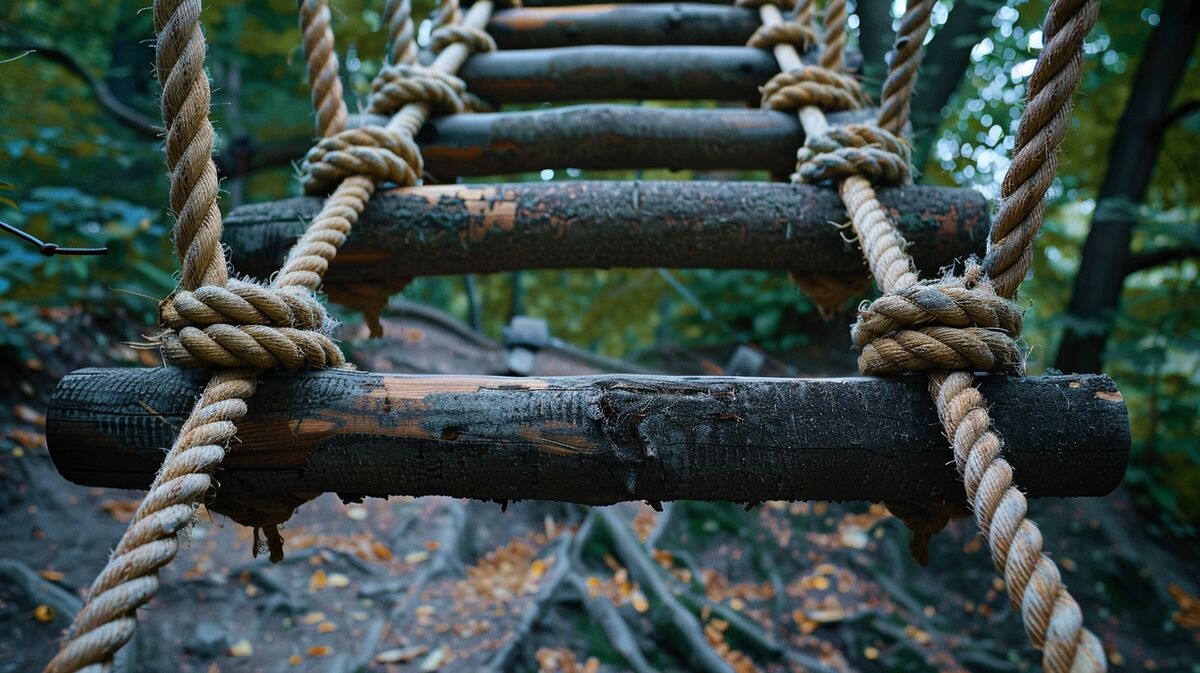
Rope ladder
Noun
Meaning
A rope ladder is a type of ladder made from ropes or cords that are connected by rungs or steps. It is commonly used in survival, bushcraft, and outdoor activities such as camping, hiking, and wilderness exploration. The rope ladder is lightweight, portable, and easy to assemble, making it a valuable tool for accessing elevated areas or crossing obstacles in the wild. It is especially useful in situations where traditional ladders or stairs are not available or practical. With its versatility and simplicity, the rope ladder is an essential piece of equipment for anyone venturing into the great outdoors.

Examples
„I remember the time when I was out in the wilderness with my friends, and we needed to climb up a tall tree to get a better view of our surroundings. Luckily, I had brought my trusty rope ladder with me.“
„As we set up the rope ladder, my friend exclaimed, "This rope ladder is so sturdy! I feel safe climbing up it."“
„Later that day, we came across a deep ravine that we needed to cross. With the help of the rope ladder, we were able to create a makeshift bridge and safely make our way to the other side.“
„During a survival training session, one of the participants asked, "How can we quickly escape from a building in an emergency situation?" I replied, "A rope ladder is a great tool to have in such situations. It can be easily deployed and provide a safe way to descend from higher floors."“
„In a conversation with a fellow bushcrafter, he mentioned, "I always carry a rope ladder in my backpack. It's a versatile tool that can be used for various purposes, from climbing trees to creating shelters."“
„“
Origin
The word "rope ladder" originates from the combination of two separate words: "rope" and "ladder".
The term "rope" can be traced back to the Old English word "rap", which means "cord" or "twisted strands". It has its roots in the Proto-Germanic word "rap-", which signifies "rope" or "cord". The word "rope" has been used for centuries to describe a strong and flexible material made by twisting or braiding fibers together.
The word "ladder" comes from the Old English word "hlæder", which is derived from the Proto-Germanic word "hlaidrijan". The concept of a ladder has been present in human history for thousands of years, with early examples made from natural materials such as wood or vines.
The combination of these two words, "rope" and "ladder", refers to a type of ladder made from ropes or cords. Rope ladders have been used for various purposes throughout history, including in maritime settings, construction sites, and even in military operations.
Over time, rope ladders have evolved in design and materials used, with modern versions incorporating lightweight and durable materials such as nylon or synthetic fibers. They continue to be an essential tool in situations where a portable and flexible means of climbing or descending is required.
Synonyms
Ladder, Climbing rope, Rope steps, Rope rungs, Rope bridge, Rope stairs, Rope ascent, Rope descent
Antonyms
Solid ground, Stable surface, Firm footing, Secure foundation, Steady platform, Stable base, Reliable support, Sturdy structure
Relatives
Rope, Ladder, Climbing, Height, Safety, Knots, Outdoor, Adventure
Historical and cultural importance
A rope ladder has a long history and holds cultural significance in various contexts. Throughout history, rope ladders have been used for a multitude of purposes, including in ancient civilizations, maritime settings, and military operations.
In ancient times, rope ladders were used by civilizations such as the Egyptians and the Romans. They were often employed in the construction of structures like pyramids and siege towers, allowing workers and soldiers to access higher levels. These ladders were made from natural fibers like hemp or flax.
In maritime settings, rope ladders were essential for sailors and pirates alike. They provided a means of boarding or disembarking from ships, especially when docking was not possible. Rope ladders were also used for emergency situations, such as when sailors needed to abandon ship quickly.
Furthermore, rope ladders played a crucial role in military operations. They were used for scaling walls during sieges, allowing soldiers to breach fortifications. Rope ladders were also utilized in special forces operations, enabling troops to access elevated positions or conduct covert missions.
Today, rope ladders continue to be used in various fields, including outdoor activities, rescue operations, and even in children's play equipment. Their versatility, durability, and ease of use make them a valuable tool in many situations.
Whether you're a survivalist, an adventurer, or simply someone who enjoys outdoor activities, understanding the historical and cultural significance of the rope ladder adds depth to your knowledge and appreciation of this essential piece of equipment.
More information about the term Rope ladder
What is a Rope Ladder?
A rope ladder is a type of ladder made entirely out of rope. It consists of several rungs or steps that are connected by two long ropes on either side. Rope ladders are lightweight, portable, and versatile, making them a popular choice for various outdoor activities, including survival situations, camping, and tree climbing.
Uses of a Rope Ladder
Rope ladders have a wide range of uses in different scenarios. Here are a few examples:
1. Emergency Situations: In survival situations, a rope ladder can be a valuable tool. It can be used to climb up or down steep terrain, cross obstacles such as rivers or ravines, or escape from dangerous situations.
2. Camping and Hiking: Rope ladders are often used in camping and hiking trips. They can be used to access elevated platforms, such as treehouses or elevated camping spots. Rope ladders are also useful for hanging food away from animals or creating makeshift shelters.
3. Tree Climbing: Rope ladders are commonly used by arborists, tree climbers, and adventurers who enjoy climbing trees. They provide a safe and secure way to ascend and descend trees, allowing climbers to explore the canopy or perform tree maintenance tasks.
Benefits of Using a Rope Ladder
There are several advantages to using a rope ladder:
1. Portability: Rope ladders are lightweight and easy to carry, making them ideal for outdoor activities where weight and space are limited.
2. Versatility: Rope ladders can be used in various situations and environments. They can be easily adjusted to different lengths and can be attached to different anchor points, such as trees, rocks, or structures.
3. Durability: Rope ladders are typically made from strong and durable materials, such as nylon or polyester. They are designed to withstand outdoor conditions and heavy use.
4. Easy to Store: Rope ladders can be rolled up or folded into a compact size, making them easy to store and transport.
Tips for Using a Rope Ladder
Here are a few tips to keep in mind when using a rope ladder:
1. Inspect the ladder: Before using a rope ladder, carefully inspect it for any signs of damage or wear. Check the ropes, rungs, and connections to ensure they are in good condition.
2. Secure the ladder: Make sure the ladder is securely attached to a stable anchor point before climbing. Test the ladder's stability before putting your full weight on it.
3. Use proper climbing techniques: When climbing a rope ladder, use proper climbing techniques, such as maintaining three points of contact and keeping your weight centered on the ladder.
4. Practice ladder safety: Always follow ladder safety guidelines, such as not overloading the ladder, avoiding sudden movements, and using appropriate safety equipment, if necessary.
By following these tips and using a rope ladder responsibly, you can safely enjoy its benefits in various outdoor activities and survival situations.
Back to overview

